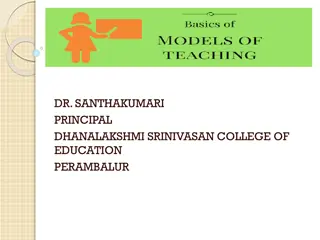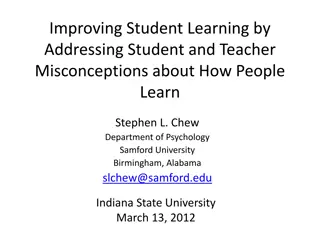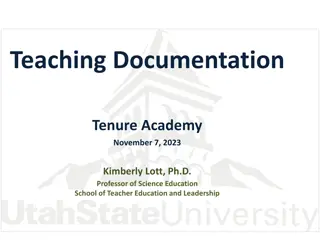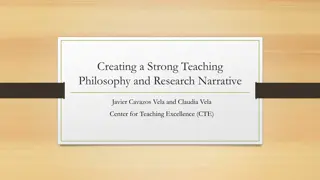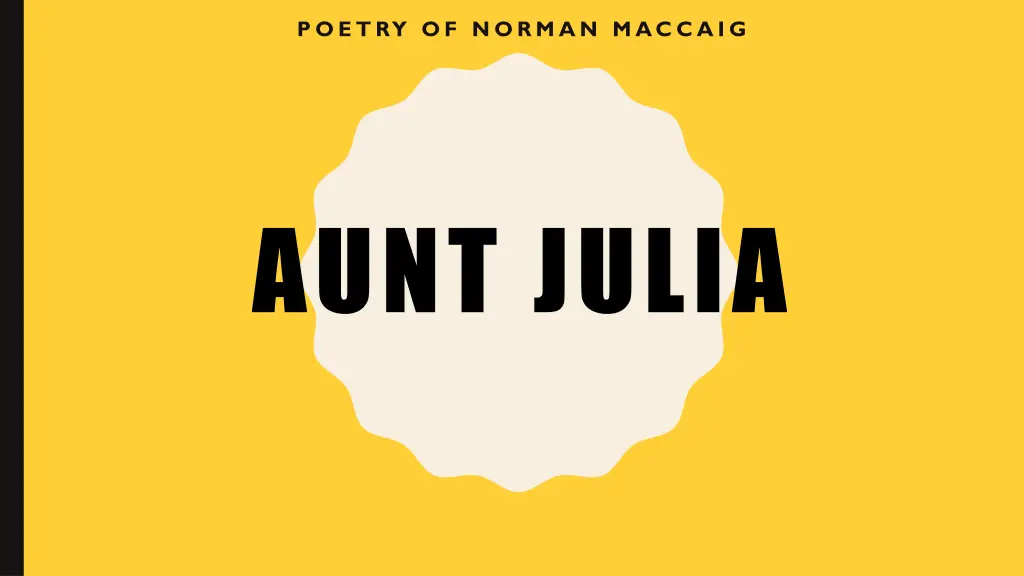
Exploring MacCaig's Poem on Aunt Julia's Unspoken Love
Delve into the emotional depth of Norman MacCaig's poignant poem about his Aunt Julia, who lived on a remote Scottish island, speaking only Gaelic. Despite the language barrier, MacCaig expresses deep love and admiration for her, reflecting on the complexities of communication, love, and loss. Explore themes of isolation, love transcending barriers, and the reflective nature of the poem, all captured in vivid imagery and free verse structure.
Download Presentation

Please find below an Image/Link to download the presentation.
The content on the website is provided AS IS for your information and personal use only. It may not be sold, licensed, or shared on other websites without obtaining consent from the author. If you encounter any issues during the download, it is possible that the publisher has removed the file from their server.
You are allowed to download the files provided on this website for personal or commercial use, subject to the condition that they are used lawfully. All files are the property of their respective owners.
The content on the website is provided AS IS for your information and personal use only. It may not be sold, licensed, or shared on other websites without obtaining consent from the author.
E N D
Presentation Transcript
POETRY OF NORMAN MACCAIG AUNT JULIA
Poets Main Idea MacCaig s Aunt Julia lived in a remote Scottish island called Scalpay She lived a traditional crofting life and only spoke Gaelic, which MacCaig didn t. Despite the fact that he didn t speak Gaelic he had strong feelings of love and admiration of his aunt MacCaig explores the anger and frustration at the barrier between him and his aunt, first through language and then when she dies At the end of the poem he explores the finality of death and how he can no longer communicate with his aunt.
Reflective Nature of the Poem In the interview A Metaphorical Way of Seeing Things , MacCaig maintained that poetry clears your eyes and you see things . MacCaig reflects throughout the poem on the ways that we are connected to people through love and the different kinds of barriers that stop us communicating
Themes Isolation due to communication barrier he is unable to truly communicate with his aunt and learn from her. Also shows that love can transcend any barrier shown through his obvious affection to his Aunt
Structure First person Free verse echoing the personality of Aunt Julia Each stanza begins with a reference to Aunt Julia showing her importance
Stanza One Aunt Julia spoke Gaelic very loud and very fast. I could not answer her I could not understand her. Think about: - What do we learn about Aunt Julia in this stanza? - What do we learn about the poet in this stanza? - What is the relationship between the poet and his aunt?
Stanza One The poem immediately begins with her name showing her importance Immediately introduces the language barrier, showing the issue and isolation Repetition of very emphasises her personality: She is confident and an Repetition of very emphasises her personality: She is confident and an extrovert extrovert Aunt Julia spoke Gaelic very loud and very fast. I could not answer her I could not understand her. Repetition to reinforce the barrier between them the lack of ability to communicate is the issue to overcome and the cause of isolation. Repeating it makes him sound frustrated about this.
Stanza Two She wore men's boots when she wore any. I can see her strong foot, stained with peat, paddling with the treadle of the spinning wheel while her right hand drew yarn marvellously out of the air. Think about: - What do we learn about Aunt Julia in this stanza? - What emotion does the poet have towards his aunt? - What does this tell you about Aunt Julia s life?
Stanza Two She is not conventionally feminine she works so she prefers practicality over beauty Powerful shows the speakers admiration She wore men's boots when she wore any. I can see her strong foot, stained with peat, paddling with the treadle of the spinning wheel while her right hand drew yarn marvellously out of the air. Shows her connection to her land. Creates a vivid impression of how she looks and stained makes it clear she is out working often Shows her connection to Scottish island life she works with her hands and she is skilled at her work Her skill is almost magic shows his admiration again
Stanza Three Hers was the only house where I've lain at night in the absolute darkness of a box bed, listening to crickets being friendly. Think about: - What do we learn about Aunt Julia in this stanza? - What do we learn about where Aunt Julia lives? - How does MacCaig feel staying at her house?
Stanza Three Show the special bond between aunt and MacCaig he has memories with her that he has no where else Hers was the only house where I've lain at night in the absolute darkness of a box bed, listening to crickets being friendly. Word choice of absolute makes it clear how incredibly dark it is but bond with aunt means he is not scared/worried Reinforces that he is comfortable and happy staying with his aunt. Creates a happy atmosphere No full stops in this stanza, creating a sense of pace and excitement, further emphasising the happy atmosphere
Stanza Four She was buckets and water flouncing into them. She was winds pouring wetly round house-ends. She was brown eggs, black skirts and a keeper of threepennybits in a teapot Think about: - What do we learn about Aunt Julia in this stanza? - What do we learn about where Aunt Julia lives?
Stanza Four Metaphors Shows the power and strength of her character: as sturdy as a bucket and as powerful as wind. These are all natural metaphors: she is symbol of the land, nature and the elements She was buckets and water flouncing into them. She was winds pouring wetly round house-ends. She was brown eggs, black skirts and a keeper of threepennybits in a teapot. Makes it clear she works hard to avoid poverty and represents a hard- working life
Stanza Five Aunt Julia spoke Gaelic very loud and very fast. By the time I had learned a little, she lay silenced in the absolute black of a sandy grave at Luskentyre. But I hear her still, welcoming me with a seagull's voice across a hundred yards of peatscrapes and lazybeds and getting angry, getting angry with so many questions unanswered. Think about: - What do we learn about Aunt Julia in this stanza? - What is the final tone of the poem?
Repetition from first stanza makes us think it will be similar, however this stanza is darker than stanza one, so the repetition strengthens the dark and sad tone Stanza Five Tried to communicate but it was too late relates to themes of isolation (he never got to communicate) and love (he tried because he loved her) Contrast to the talkative and active life she had, it is sad to see her silent Aunt Julia spoke Gaelic very loud and very fast. By the time I had learned a little, she lay silenced in the absolute black of a sandy grave at Luskentyre. But I hear her still, welcoming me with a seagull's voice across a hundred yards of peatscrapes and lazybeds and getting angry, getting angry with so many questions unanswered. Refers back to absolute darkness but this time she cannot provide comfort, so now the black makes us think of death and the grave But shifts us away from the sad tone the memories can bring us back to the happiness Reinforces bond and love that they have we have moved to a nostalgic and happy tone Metaphor: she is loud and incomprehensible. Strengthens connection to nature Repetition emphasises the anger and frustration that they will be forever isolated Unanswered is emphasised through being on a line of its own. Sense of frustration about lack of communication and the things he will never know
An Overview of the Stanzas Stanza One - introduces us to the subject of the poem- Aunt Julia. Stanza Two - describes her physical appearance and the objects MacCaig most strongly associates with her. Stanza Three - the perspective moves away from Julia to the way the poet felt when he visited her. Stanza Four - MacCaig uses personification to create a sense of her character. Stanza Five - The concluding stanza reflects on his own frustration that he was unable to communicate effectively with her while she was alive, whilst at the same time expressing his enduring affection and admiration for her.
Revision Tasks To help you remember the key points of the poem you should: Write a summary of the poem showing how the poet explores the feelings MacCaig has for his Aunt Identify a key quote for each of the following points: MacCaig s inability to communicate with his Aunt His Aunt s enthusiasm and energy His Aunt s connection to nature His despair and anger about her death Write down and analyse any images used
Revision Question 1 Show how the writer s use of language immediately introduces us to the main themes of the poem in line 1-4? (2)
Revision Question 2 Explain how the language used lines 5-16 make it clear that the speaker has a very positive opinion of Aunt Julia (4)
Revision Question 3 Show how the writer s use of imagery in line 17-23 shows us some of the things the speaker admires about Aunt Julia (2)
Revision Question 4 Explain how the writer s use of contrast in lines 23-37 show proves that he has had a mixed reaction to the death of Aunt Julia (4)




